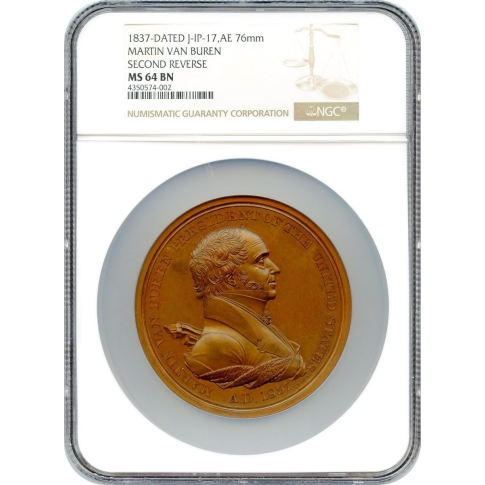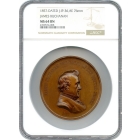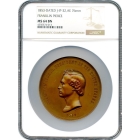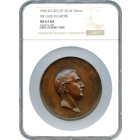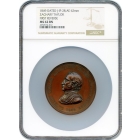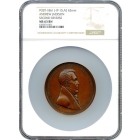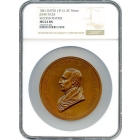Indian Peace Medal - 1837 Martin Van Buren, J-IP-17 Second Reverse AE 76mm NGC MS64
Peace Medals were instrumental in building relationships with the various Indian Tribes. American Presidents (and their Colonial predecessors) used Indian Peace Medals as a way of placating various tribes and/or to build alliances with them. The recipients valued them highly, for they conferred a prestige that was recognized throughout the nation. The Bureau of Indian Affairs considered them crucial and the Presidents for whom they were issued also knew their importance. Many images from the "Old West" show Indians proudly wearing their Peace Medals (sometimes more than one). Generally, bronze medals were not used for presentation purposes, but in some cases, they were silver-plated and either given, sold, or traded away by unscrupulous individuals to unwitting recipients.
NGC total census of 8 medals. 3 are in this Very Choice Brilliant Uncirculated grade with 1 finer (MS65 is finest at this time).
Martin Van Buren Indian Peace Medals
The creation of the IPMs carrying the image of Martin Van Buren went quite smoothly, compared to the delays involved in the Andrew Jackson IPMs. It was around the end of April 1837 that Carey A. Harris, the new Commissioner of Indian Affairs, started to make arrangements to produce the medals after getting approval from the Secretary of War. Harris wrote to Robert M. Patterson, who became Mint Director in 1835. Patterson was proactive in the Mint's role in the production of IPMs during his lengthy tenure there. He suggested that Moritz Fürst be hired to cut the three dies for this medal.
Patterson arranged to have Chief Coiner Adam Eckfeldt manage the striking of the medals, and also wrote to Fürst, who agreed to sink the dies for $1,000, the same fee he received for the three previous IPMs. Fürst visited Van Buren, sketching his profile at the White House. By May 26, Fürst wrote that the first die was ready for the lettering to be stamped upon it. As was he modus operandi, he used the mid-sized die as his "original" from which he adapted the image for the large and small medals. Around mid-June, Fürst sent impressions of the first die to the Mint and War Department.
On September 13,1837, Harris wrote to Patterson, telling him that a deputation of Indians would be arriving in Washington shortly, and that it was important for him to have medals to present to them. Patterson wrote back that by the end of the week the coiner would ship some of the middle and small medals to him, and that the "larger size may detain him two or three days longer, but, if the deputation remain in Washington two weeks, I think I can safely promise all the varieties." The first box of medals was sent on September 20, and the final shipment was on October 31. More medals were produced at a later date for the Indian Office. April of 1838 saw William Clark, Superintendent of Indian Affairs at St. Louis, request six large medals to give Indian trader Charles Bent to present to Arapaho and Cheyenne chiefs. It took a while for them to be produced, and then large medals were sent to Washington at the end of August. Clark got the first medals that were struck, for Harris wrote him, "When the medals are received, they will be forwarded to you, to be furnished to Mr. Bent, if in season, or used on other occasions as you may think proper."
Martin Van Buren and the Indians
Martin Van Buren, who served as secretary of state and vice president, respectively, during Andrew Jackson's two terms, vowed to continue enforcing his predecessor's policies, which included the Indian Removal Act of 1830. In his autobiography, Van Buren praised Jackson's Indian policies. He wrote, "No man ever entered upon the execution of an official duty with purer motives, firmer purpose or better qualifications for its performance. We were perhaps in the beginning unjustifiable aggressors [towards the Indian tribes, however] we have become the guardians and, as we hope, the benefactors."
Upon taking office in 1837, Van Buren behaved brutally towards the Cherokee. The Treaty of New Echota had been dishonestly negotiated, nonetheless Van Buren sent the military to the Cherokee Nation, rounding up each and every tribal member and threw them into internment camps. December 1837 saw Van Buren tell Congress that Indians removal was "the settled policy of the country....The decrease in numbers of the tribes within the limits of the states and territories has been most rapid. If they be removed, they can be protected from those associations and evil practices which exert so pernicious and destructive an influence their destinies." It was during late 1838 that the Cherokee traveled the Trail of Tears to new lands. During Van Buren's administration, about 4,000 Cherokee died and other Indian nations were relocated, some of which lost up to half of their populations. Defending the Cherokee removal, he told Congress in December 1838, "that a mixed occupancy of the same territory by the white and the red man is incompatible with the safety or happiness of either," and that the Cherokee had "emigrated without any apparent reluctance."
Martin Van Buren Indian Peace Medals for Indians and Collectors
Dated 1837, all original Van Buren IPMs were struck on solid silver planchets. They were produced in three sizes: 76 mm, 62 mm, and 51 mm. An original medium-sized (62 mm) Van Buren medal sold at auction via Stacks Bowers. Graded Very Fine (uncertified) by Stacks Bowers, it fetched a price of $18,800 in March-April of 2016. A bronze restrike of the large (76 mm) medal sold at auction graded uncirculated (and uncertified) by Heritage Auctions. It sold for $2,125 in May of 2016. It was typically the medium-sized Van Buren IPM (62 mm) that was sold to the public when the Mint began producing restrikes in 1861.
| Grading Service | NONE |
|---|---|
| Year of Issue | NONE |
| Grade | NONE |
| Denom Type | N/A |
| Numeric Denomination | Medal |
| Mint Location | NONE |
| Designation | NONE |
| Circ/UnCirc | Not Specified |
| Strike Type | N/A |
| Holder Variety | Martin Van Buren: J-IP-17, AE, 76mm Second Reverse |
| Grade Add On | NONE |
| Holder Type | N/A |

